Modelling a Severe Transient Anoxia of Continental Freshwaters Due to a Scheldt Accidental Release (Sugar Industry)
Abstract
1. Introduction
2. Materials and Methods
2.1. Data
2.2. Method
2.2.1. Mathematical Representation
- -
- A term of advection describing the transportation of the pollutant along the river;
- -
- A term of longitudinal dispersion describing the “mixing” of pollutants in the river (it is constituted by “true turbulence” and the additional term of “shearing diffusion”);
- -
- A term of injection of upstream supplies and releases in discrete points;
- -
- A term describing the load brought by the upstream tributaries , and a term composed of internal production and disappearances .
- -
- is the evolution of the concentration C (g/m³) in water with time (s)
- -
- is the velocity of the stream (m/s)
- -
- is the spatial evolution (m) of the concentration C (g/m³) in water
- -
- is the hydrodynamic dispersion coefficient (m²/s)
- -
- is the release (g/s) in the river
- -
- is the right section of the river (m²) at the release point
- -
- is the distance (m) from the river source
- -
- is the distance (m) from the river source of the release point
- -
- is the distance (m) from the river source of the tributary k
- -
- is the flow (m³/s) of the tributary k
- -
- is the concentration (g/m³) of the tributary k
- -
- is the right section (m²) at the confluence with the tributary k
- -
- is the productions (g.m−³.s−1)
- -
- is the disappearances (g.m−³.s−1)
2.2.2. Scheldt Application
- -
- The release started on 10 April at 12 a.m. and ended on 11 April at 6 a.m. (during 30 h);
- -
- The maximum release occurred on 10 April at midnight (discharge flow rate of 1.5–2 m³/s), decreasing linearly until 11 April at 6 a.m.. At that date and hour, the flow rate of the release fell down to zero;
- -
- The initial concentration of pollutants was considered as the one measured originally in the pond;
- -
- The punctual release of pollutants was located on the Erclin, at its confluence with the Raperie watercourse.
3. Results and Discussion
3.1. Accidental Release in the Scheldt
3.2. Organic Matter Loads
3.3. Deoxygenation
3.4. Nitrates
3.5. Describing the Transborder Pollution
3.6. Preliminary Conclusions
4. Conclusions
Supplementary Materials
Author Contributions
Funding
Institutional Review Board Statement
Informed Consent Statement
Data Availability Statement
Acknowledgments
Conflicts of Interest
References
- Eurostat Data (2018). Available online: https://www.agriculture-strategies.eu/en/2019/07/the-european-sugar-policy-a-policy-to-rebuild (accessed on 4 September 2020).
- Sanquer, J. Le traitement et le recyclage de l’eau dans les industries agro-alimentaires. La Houille Blanche 1975, 5–6, 379–386. [Google Scholar] [CrossRef][Green Version]
- CGB Report 2018. Available online: http://www.cgb-france.fr/wp-content/uploads/2019/01/ra2018-livre-bd-v2-1.pdf (accessed on 4 July 2020).
- «La voix du Nord», Élodie Armand, 23/04/2020. Available online: https://www.lavoixdunord.fr/741925/article/2020-04-16/poissons-morts-dans-le-valenciennois-et-le-cambresis-tereos-mise-en-cause-dans (accessed on 16 July 2020).
- Everbecq, E.; Grard, A.; Magermans, P.; Deliège, J.F. Water Framework Directive and modelling using PEGOPERA simulation software. J. Model. Optim. 2019, 11, 36–50. [Google Scholar] [CrossRef]
- Deliège, J.F.; Everbecq, E.; Magermans, P.; Grard, A.; Bourouag, M.; Blockx, C. PEGASE, a software dedicated to Surface Water Quality Assessment and to European database reporting. In Proceedings of the European conference of the Czech Presidency of the Council of the EU Towards Environment, Opportunities of SEIS and SIZE: Integrating Environmental Knowledge in Europe, Masaryk University, Brno, Czech Republic, 26 March 2009; pp. 24–32. [Google Scholar]
- Deliège, J.F. Méthode d’intégration de Modèles adaptée aux Systèmes Hydrologiques Multicompartimentés. Ph.D. Thesis, Sciences de l’ingénieur, Université de Liège, Liège, Belgium, 2013. [Google Scholar]
- Interreg IIIB ENO Scaldit Project. Analyse Transnationale de l’état des Lieux du District Hydrographique International de l’Escaut: Projet Pilote Pour le Test Des Documents Guides Européens. Report, Décembre 2004. Available online: http://environnement.wallonie.be/rapports/de/2004/eau2004.pdf (accessed on 20 July 2020).
- Grard, A.; Everbecq, E.; Bourouag, M.; Lange, S.; Deliège, J.F.; Smitz, J. Modélisation Transnationale de la Qualité de l’eau de Surface du Bassin de l’Escaut dans la Perspective de la Coordination DCE: Situation de référence (Année 2000/2002) et Scénario Prospectif 2015-Mesures de Base; Service Public de Wallonie: Namur, Belgium, 2006; 54p. [Google Scholar]
- Manivasakam, N. Industrial Effluents Origin, Characteristics, Effects, Analysis and Treatment; Chemical Publishing Company, 2016; 592p. [Google Scholar]
- Simpson, D.E.; Hemens, J.; Cox, S.M.H. Aerobic Treatment of Sugar Mill Effluent with the Addition of Nutrients. In Proceedings of the South African Sugar Technologists’ Association, June 1972; Available online: http://citeseerx.ist.psu.edu/viewdoc/versions?doi=10.1.1.381.5735 (accessed on 20 July 2020).
- Simpson, D.E.; Hemens, J. Activated sludge treatment of sugar mill/wattle bark mill effluents at Dalton, Natal. In Proceedings of the South African Sugar Technologists’ Association, June 1978; Available online: https://www.researchgate.net/publication/242528498_ACTIVATED_SLUDGE_TREATMENT_OF_SUGAR_MILWAlTLE_BARK_MILL_EFFLUENTS_AT_DALTON_NATAL (accessed on 20 July 2020).
- Fischer, J.H. Biological Treatment of Concentrated Sugar Beet Wastes; Office of Research and Development, U.S. Environmental Protection Agency: Washington, DC, USA, 1974; 98p. [Google Scholar]
- Loucks, D.P.; Van Beek, E. Water Resources Systems Planning and Management: An Introduction to Methods, Models and Applications; UNESCO: Paris, France, 2005; p. 698. [Google Scholar]
- Tsakiris, G.; Alexakis, D. Water quality models: An overview. Eur. Water 2012, 37, 33–46. [Google Scholar]
- Sharma, D.; Kansal, A. Assessment of river quality models: A review. Rev. Environ. Sci. Biotechnol. 2013, 12, 285–311. [Google Scholar] [CrossRef]
- Wang, Q.; Li, S.; Jia, P.; Qi, C.; Ding, F. A review of surface water quality models. Sci. World J. 2013, 2013, 231768. [Google Scholar] [CrossRef] [PubMed]
- Directive 2000/60/EC of the European Parliament and of the Council of 23 October 2000 Establishing a Framework for Community Action in the Field of Water Policy. Official Journal of the European Communities L 327. p. 72. Available online: https://eur-lex.europa.eu/legal-content/EN/TXT/PDF/?uri=OJ:L:2000:327:FULL&from=EN (accessed on 30 August 2020).
- Billen, G.; Garnier, J. Nitrogen transfer through the Seine drainage network: A budget based on the application of the ‘Riverstrahler’ model. Hydrobiologia 2000, 410, 139–150. [Google Scholar] [CrossRef]
- Garnier, J.; Billen, G.; Sanchez, N.; Leporcq, B. Ecological functioning of the Marne reservoir (upper Seine basin, France). Regul. Rivers Res. Mgmt. 2000, 16, 51–71. [Google Scholar] [CrossRef]
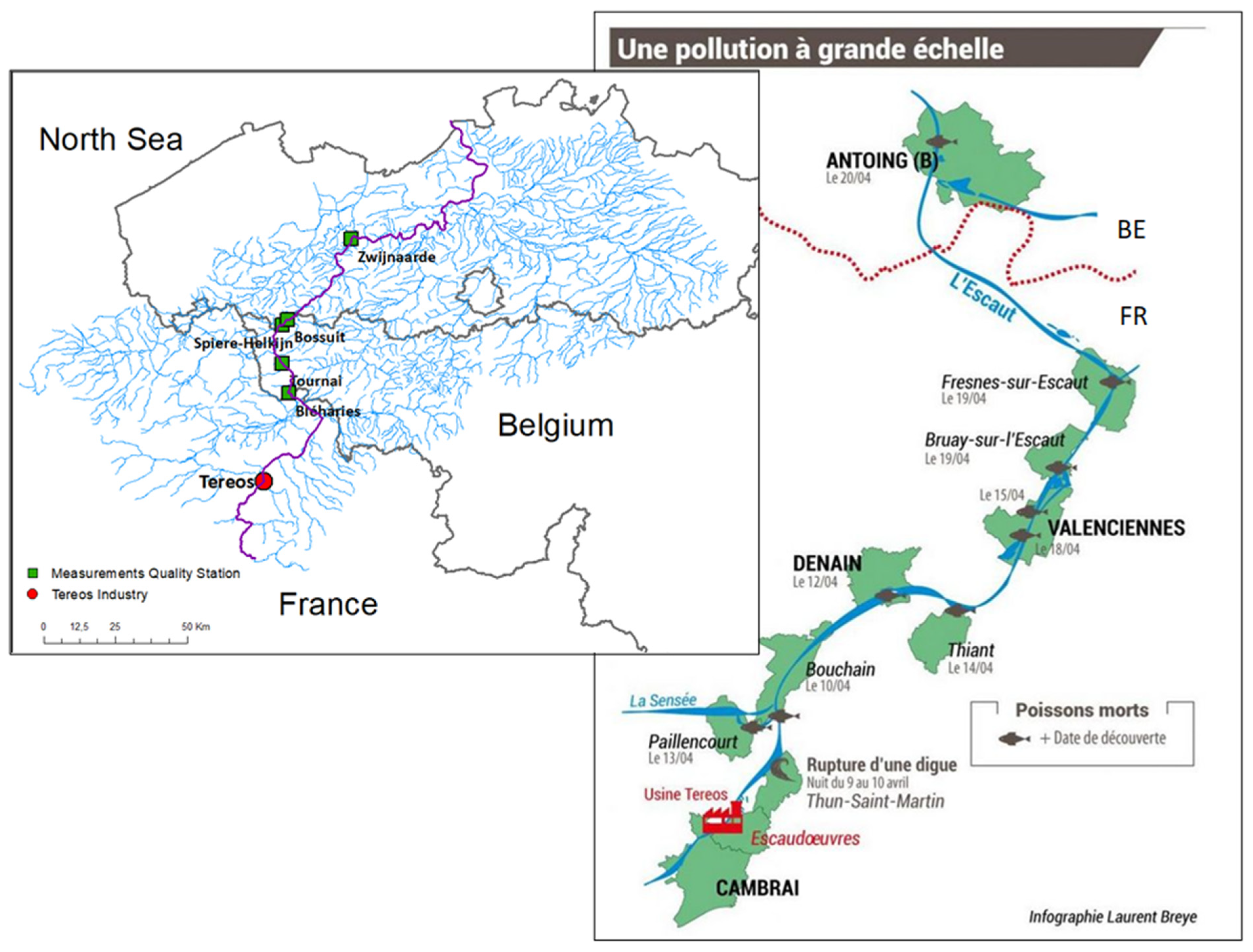
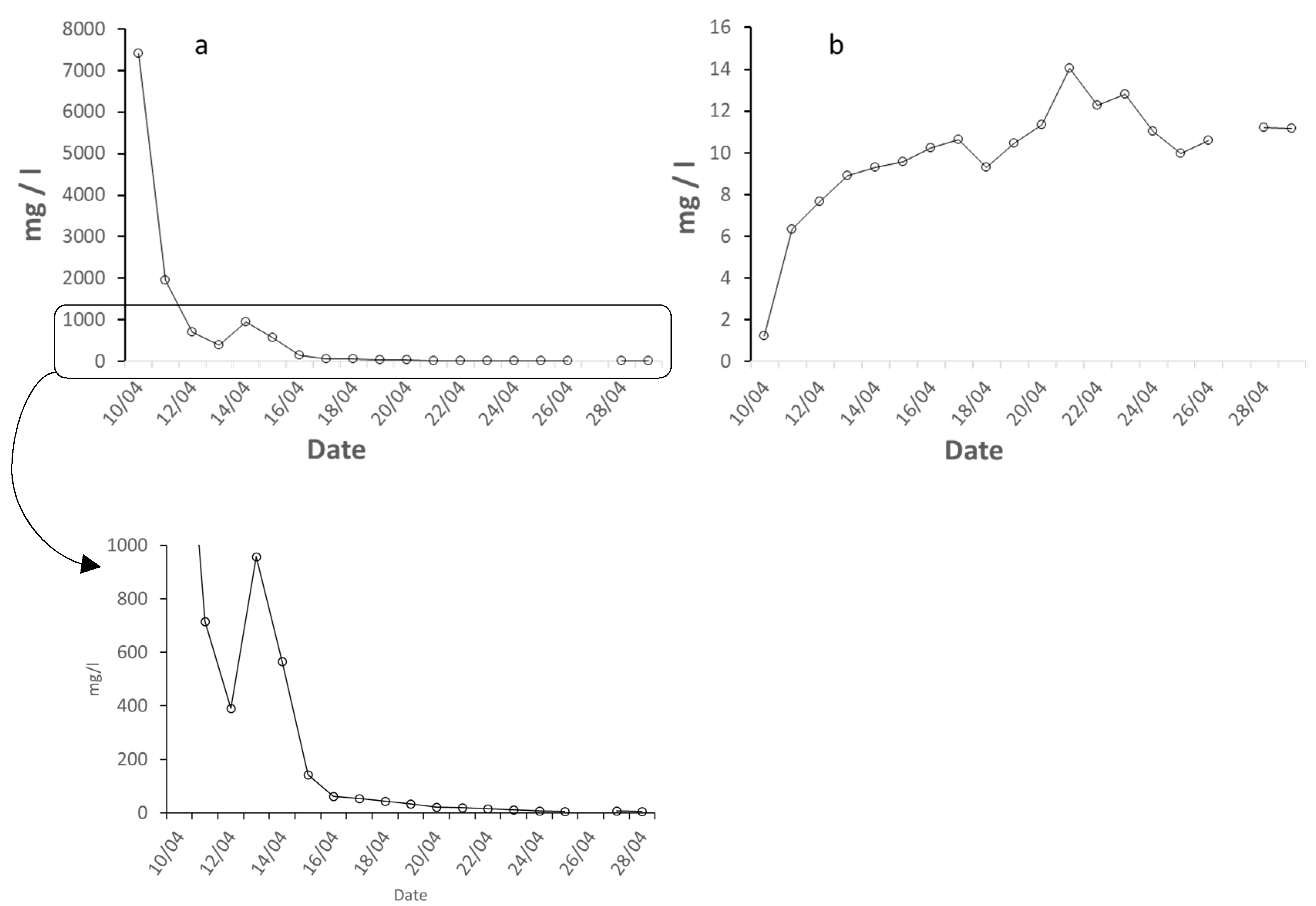
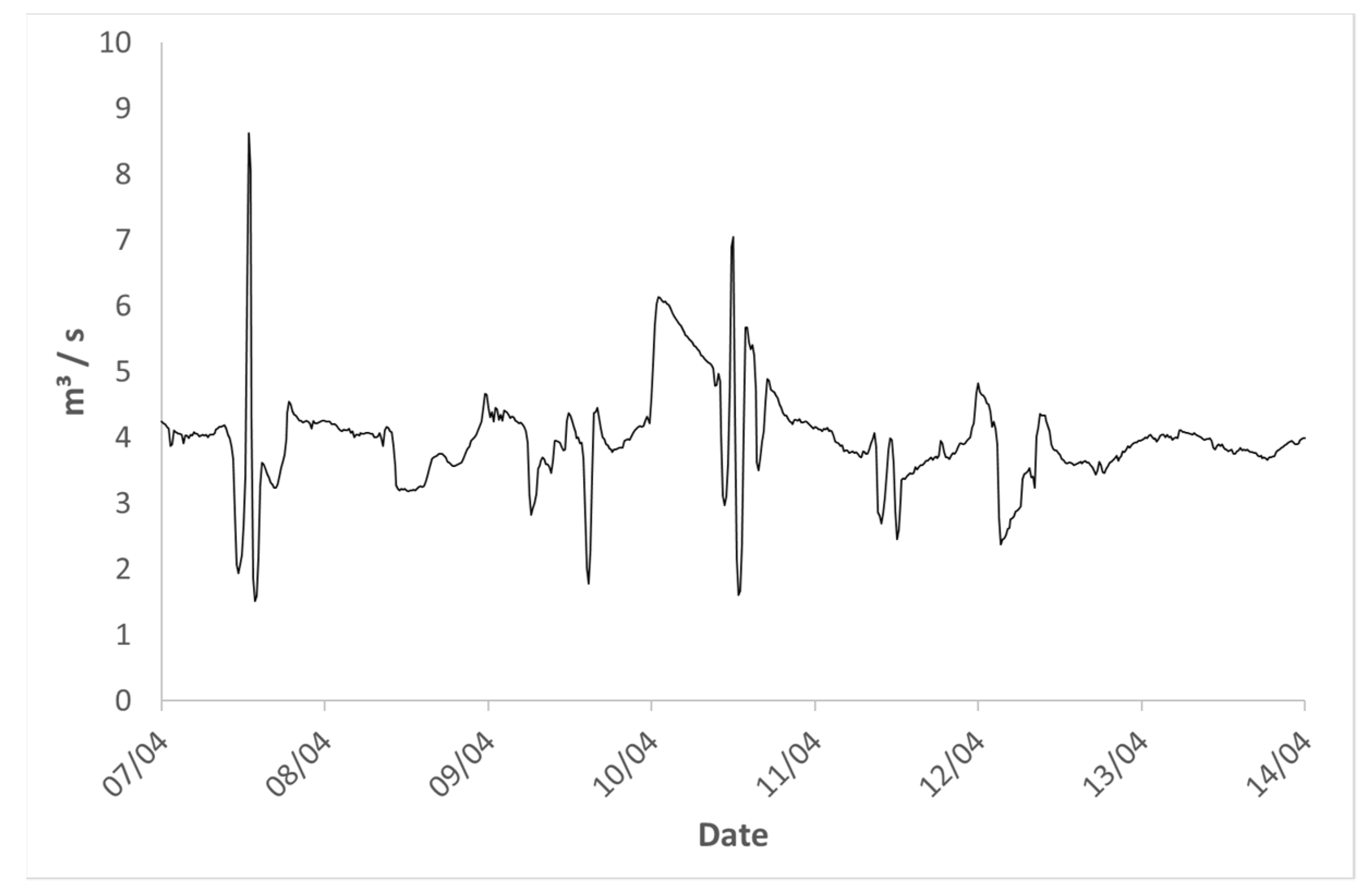
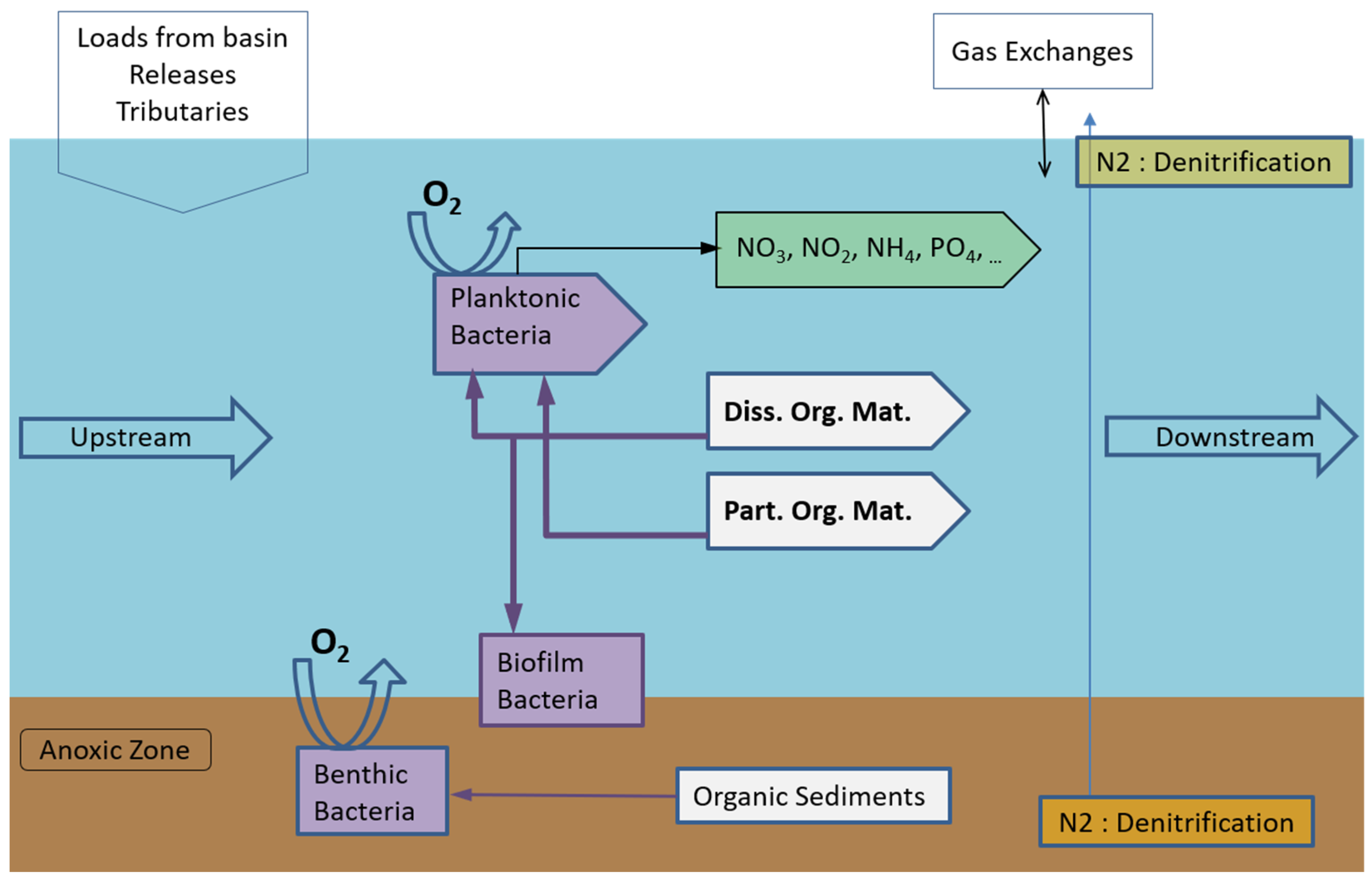

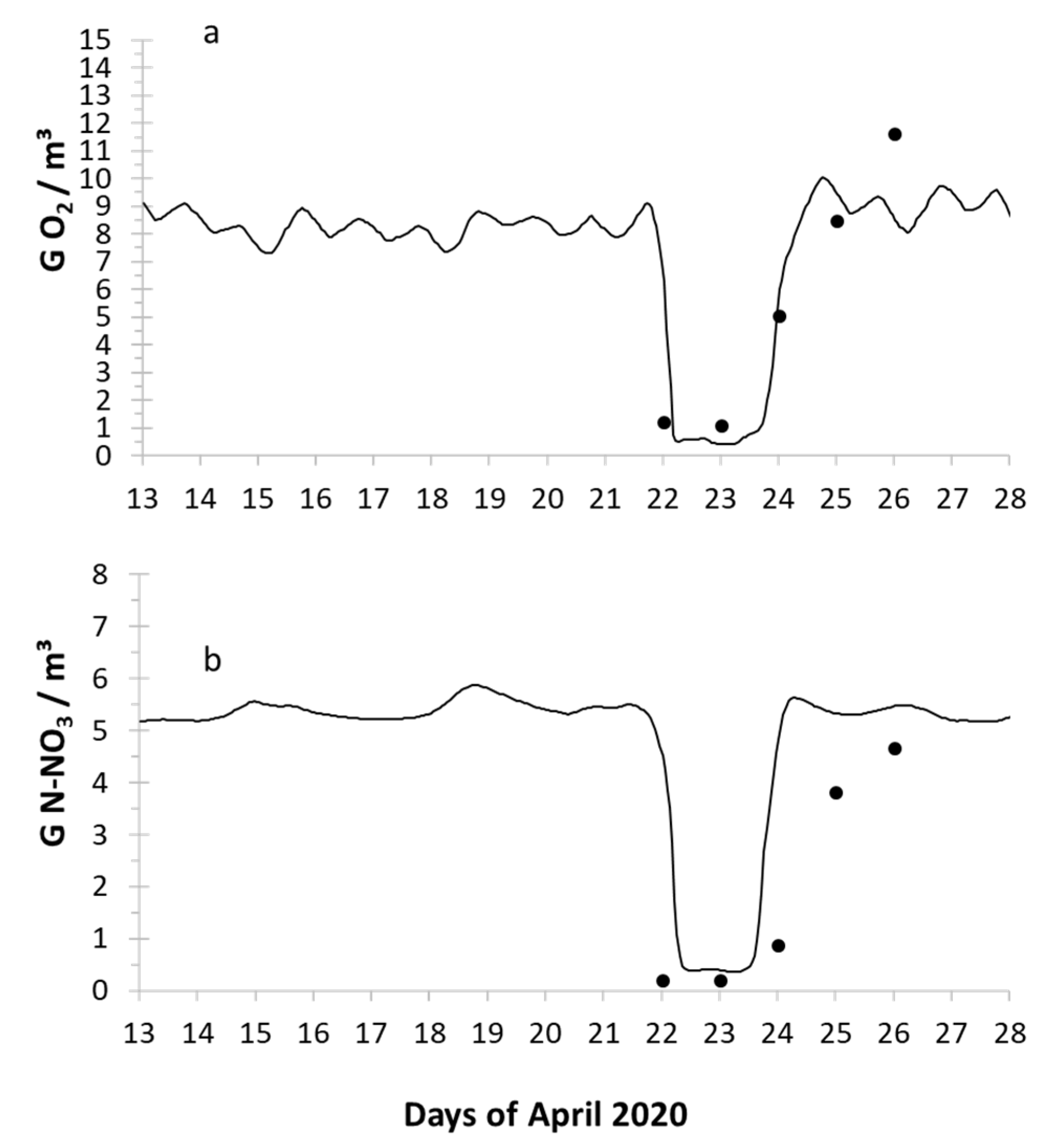
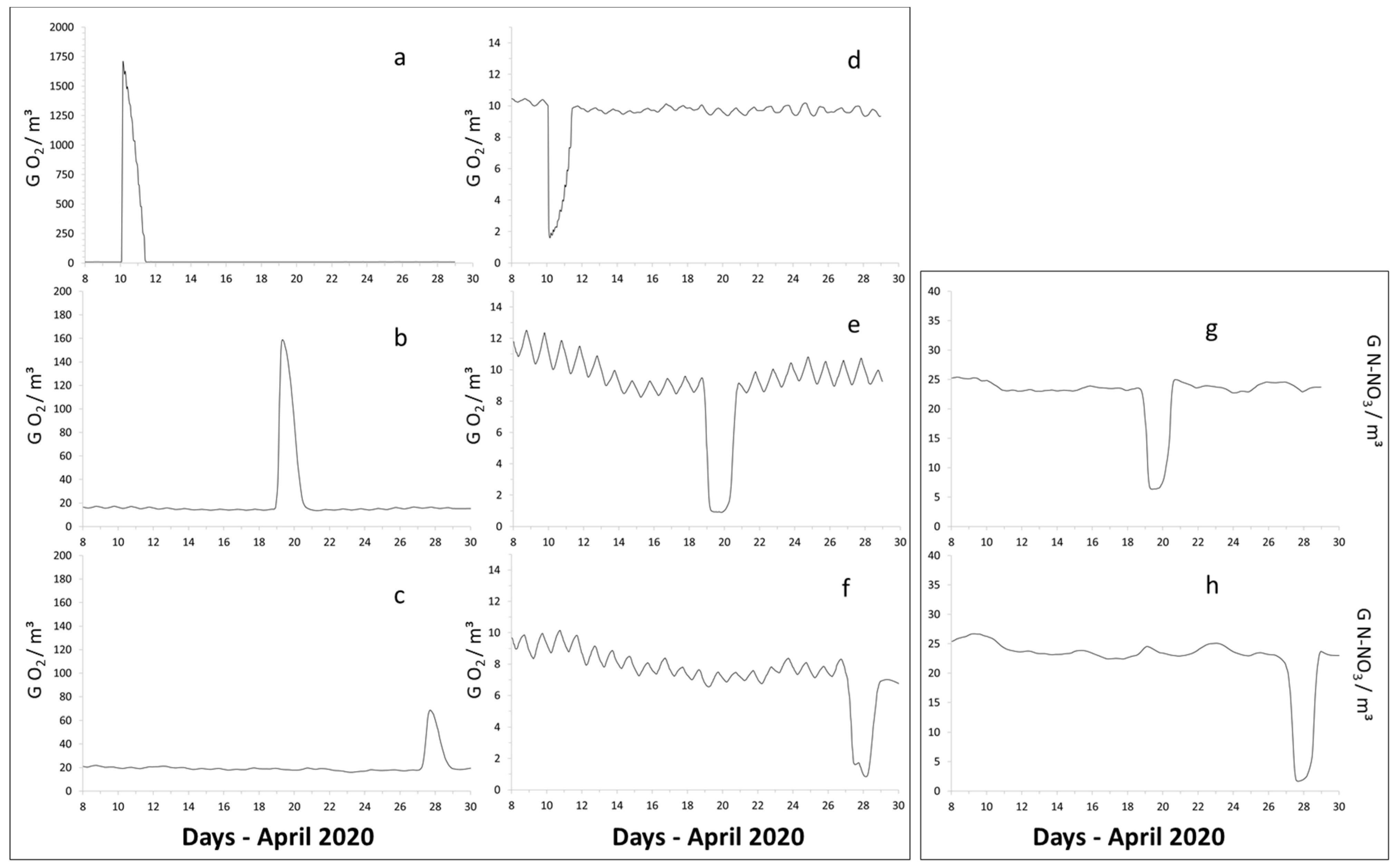
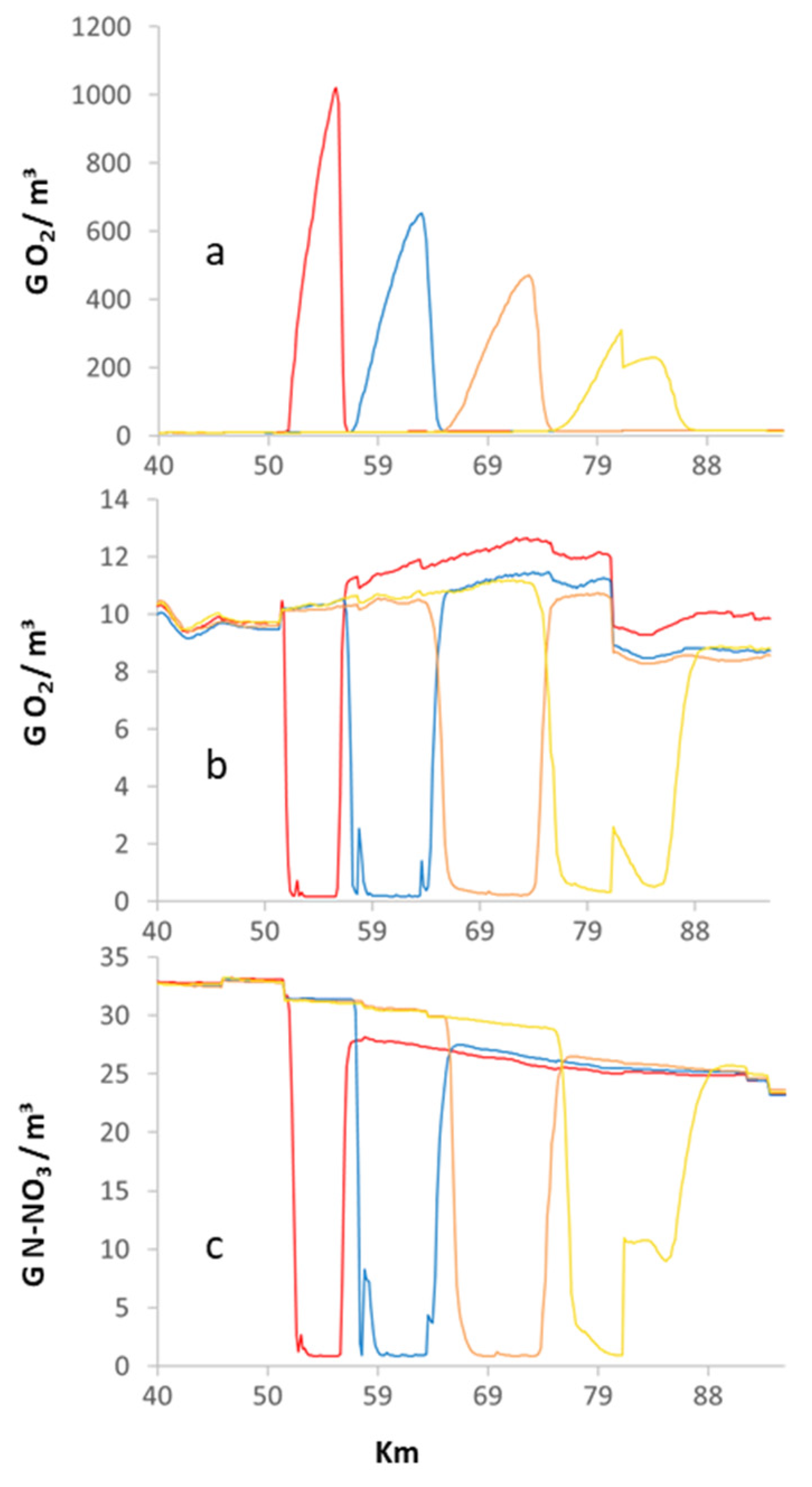
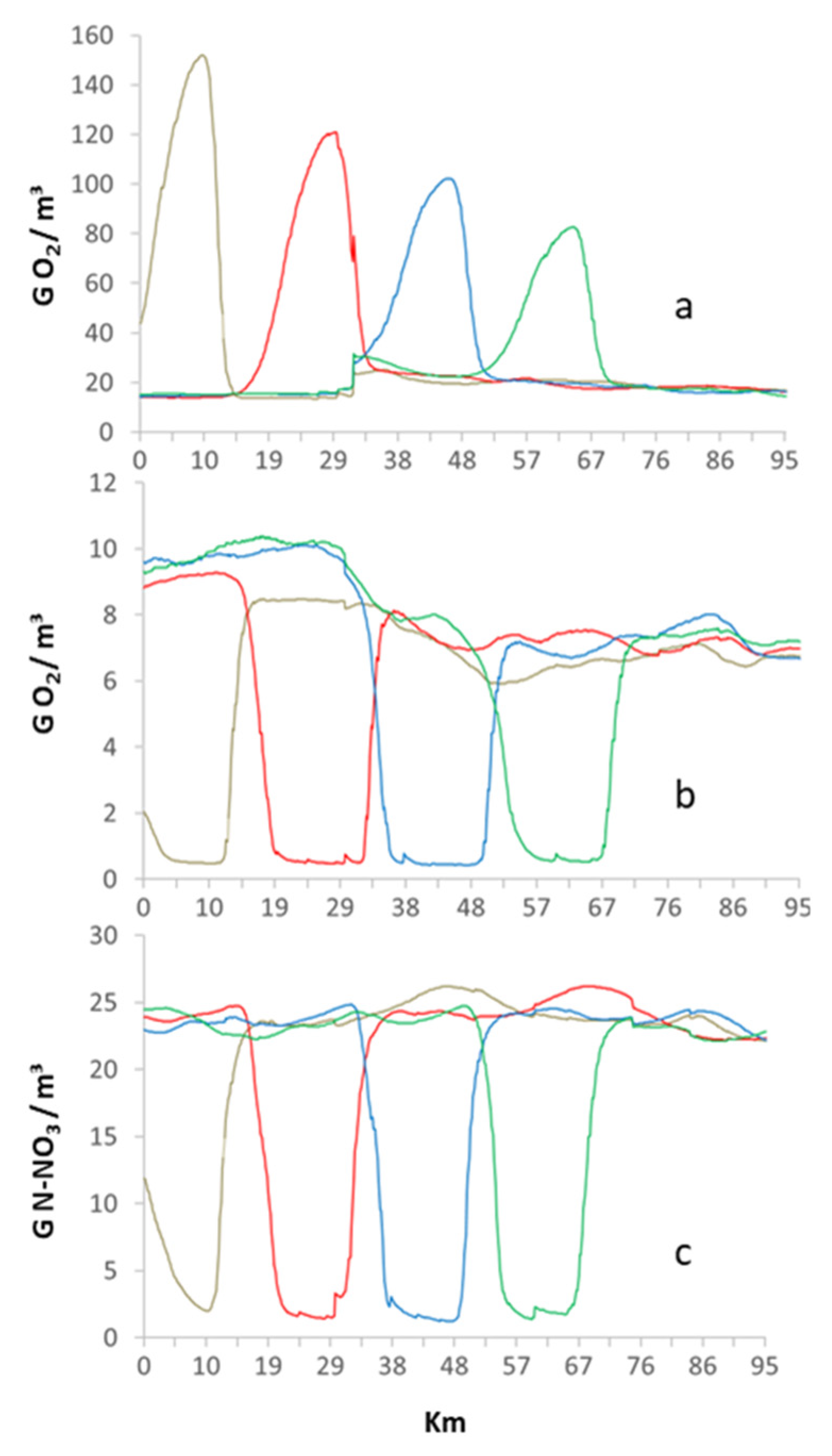
| Parameters | Concentrations | |
|---|---|---|
| Suspended Matters | 342 | mg/L |
| COD | 6330 | mgO2/L |
| pH | 7.1 | |
| Kjeldahl Nitrogen | 42.7 | mgN/L |
| Total Nitrogen | 42.7 | mg/L |
| Nitrates | <0.22 | mgN-NO3/L |
| Nitrites | <0.22 | mgN-NO2/L |
| Ammonium | 25 | mgN-NH4/L |
| Mercury | <0.20 | µg/L |
| Total Phosphorus * | 2.87 | mg/L |
Publisher’s Note: MDPI stays neutral with regard to jurisdictional claims in published maps and institutional affiliations. |
© 2021 by the authors. Licensee MDPI, Basel, Switzerland. This article is an open access article distributed under the terms and conditions of the Creative Commons Attribution (CC BY) license (https://creativecommons.org/licenses/by/4.0/).
Share and Cite
Grard, A.; Everbecq, E.; Magermans, P.; Deliège, J.-F. Modelling a Severe Transient Anoxia of Continental Freshwaters Due to a Scheldt Accidental Release (Sugar Industry). Hydrology 2021, 8, 175. https://doi.org/10.3390/hydrology8040175
Grard A, Everbecq E, Magermans P, Deliège J-F. Modelling a Severe Transient Anoxia of Continental Freshwaters Due to a Scheldt Accidental Release (Sugar Industry). Hydrology. 2021; 8(4):175. https://doi.org/10.3390/hydrology8040175
Chicago/Turabian StyleGrard, Aline, Etienne Everbecq, Pol Magermans, and Jean-François Deliège. 2021. "Modelling a Severe Transient Anoxia of Continental Freshwaters Due to a Scheldt Accidental Release (Sugar Industry)" Hydrology 8, no. 4: 175. https://doi.org/10.3390/hydrology8040175
APA StyleGrard, A., Everbecq, E., Magermans, P., & Deliège, J.-F. (2021). Modelling a Severe Transient Anoxia of Continental Freshwaters Due to a Scheldt Accidental Release (Sugar Industry). Hydrology, 8(4), 175. https://doi.org/10.3390/hydrology8040175






